|
Rowing is a sport in which athletes race against each other on river, lakes or on the ocean, depending upon the type of race and the discipline. The boats are propelled by the reaction forces on the oar blades as they are pushed against the water. The sport can be both recreational, focusing on learning the techniques required, and competitive where overall fitness plays a large role. It is also one of the oldest
Olympic sports. In the United States and
Canada, high school and collegiate rowing is sometimes referred to as
crew.
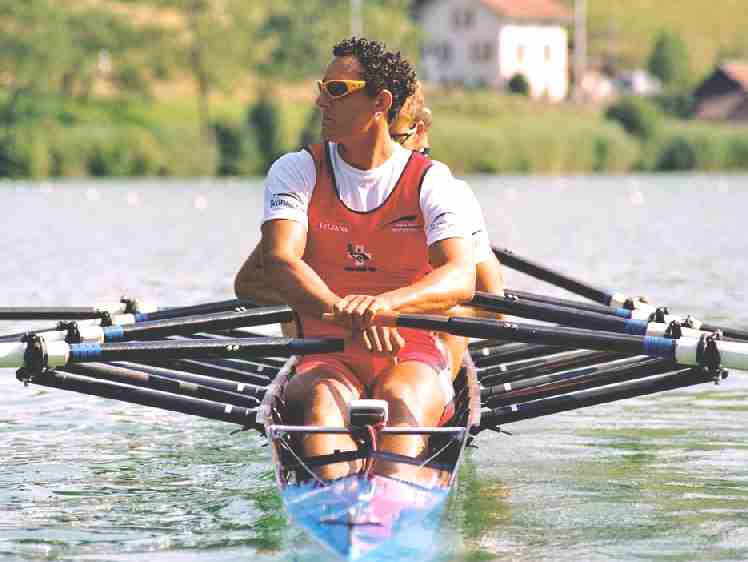
Athens
Olympic Games are this year's ultimate goal for top oarsmen and women
Basics
While rowing, the athlete sits in the boat facing backwards (towards the stern), and uses the oars which are held in place by the oarlocks to propel the boat forward (towards the bow). This may be done on a river, lake, sea, or other large body of water. It is a demanding sport requiring strong core balance as well as physical strength and cardiovascular
endurance.
Whilst the action of rowing and equipment used remains fairly consistent throughout the world, there are many different types of competition. These include endurance races, time trials, stake racing, bumps racing, and the side-by-side format used in the
Olympic
games. The many different formats are a result of the long history of the sport, its development in different regions of the world, and specific local requirements and restrictions.
There are two forms of rowing. In Sweep or Sweep-oar rowing, each rower has one oar, held in both hands. This is done in pairs, fours and eights. Each rower in a sweep boat is referred to either as "strokeside" (aka "port") or bowside (aka "starboard"), depending on which side of the boat the rower's oar extends to. In Sculling each rower has two oars (one in each hand). "Sculling" is usually done in doubles, quadruples, or singles without a coxswain. The oar in the sculler's right hand extends to stroke side, and the oar in the left hand extends to bow side.
Anatomy of a stroke
The two fundamental reference points in the rowing stroke are the catch where the oar blade is placed in the water, and the extraction (also known as the 'finish' or the 'release') where the oar blade is removed from the water. The rower leans forward, and bends the legs,sliding forward in their seat. After the blade is placed in the water at the catch, they apply pressure to the oar simultaneously sliding in their seat into the unbent legs position. The part where pressure is applied is called the drive phase of the stroke, which occurs after the blade is vertically placed in the water. Once the rower extracts the oar from the water, the recovery phase begins, setting up the rower's body for the next
stroke.
Rowing Propulsion
Rowing is a cyclic (or intermittent) form of propulsion and in the quasi-steady state the motion of the system (rower, oars and boat) is repeated regularly. In order for this perfectly cyclic motion to be maintained the sum all the external forces on the system, averaged over the cycle, must be zero, so that the system as a whole does not accelerate. In that case the average drag (retarding) force on the system must equal the average propulsion force on the system. The drag forces consists of aerodynamic drag on the superstructure of the system (everything above the waterline) and the hydrodynamic drag on the submerged portion of the system. The propulsion forces are the forward reaction of the water on the oars while in the water. Of course the oar can be used to provide a drag force (a force acting against the forward motion) when the system is brought to rest.
Although the oar can be conveniently thought of as a lever with a "fixed" pivot point in the water, the blade slips sideways and sternwards through the water, so that the magnitude of the propulsion force developed is the result of a complex interaction between unsteady fluid mechanics (the
water flow around the blade) and solid mechanics and dynamics (the handle force applied to the oar, the oar's inertia and bending characteristic, the acceleration of the boat and so on).
Distinction from other watercraft
The distinction between rowing and other forms of water transport, such as canoeing or kayaking, is that in rowing the oars are held in place at a pivot point. This allows the oars to act as a lever of force, rather than a paddle. In flatwater rowing, the boat (also called a 'shell' or 'fine boat') is narrow to avoid drag, and the oars are attached to oarlocks at the end of outriggers extending from the sides of the boat.[4] These boats also have sliding seats to allow the use of the legs in addition to the body to move the oar and so drive the boat.
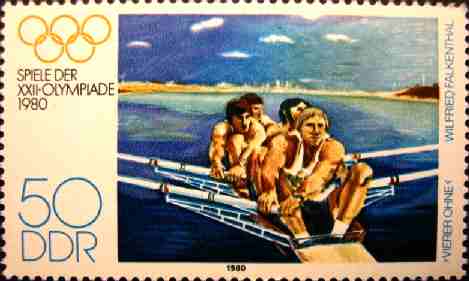
Stamp
commemorating Rowing as an Olympic Games Sport
Fitness and Health
Rowing is one of the few non-weight bearing sports that exercises all the major muscle groups, including biceps, triceps, Latissimus dorsi muscle, buttocks and abdomen. Rowing improves cardiovascular endurance and muscular strength. Rowing reduces fat but does not tend to build muscle in itself, though the associated weight training may do this.
High-performance rowers tend to be tall and muscular: although extra weight does increase the drag on the boat, the larger athlete's increased power tends to be more significant.
Rowing is a low impact activity with movement only in defined ranges, so that twist and sprain injuries are rare. However, the repetitive rowing action can put strain on knee joints, the spine and the tendons of the forearm, and inflammation of these are the commonest rowing injuries.
History
Even since the earliest recorded references to rowing, the sporting element has been present. An Egyptian funerary inscription of 1430 BC records that the warrior Amenhotep (Amenophis) II was also renowned for his feats of oarsmanship. In the Aeneid, Virgil mentions rowing forming part of the funeral games arranged by Aeneas in honour of his
father. In the 13th century, Venetian festivals called regata included boat races among
others.
The finish of the Doggett's Coat and Badge. Painting by Thomas Rowlandson.The first known ‘modern’ rowing races, began from competition among the professional watermen that provided ferry and taxi service on the River Thames in London. Prizes for wager races were often offered by the London Guilds and Livery Companies or wealthy owners of riverside
houses. During the Nineteenth Century these races were to become numerous and popular, attracting large crowds. Prize matches amongst professionals similarly became popular on other rivers throughout Great Britain in the Nineteenth Century, notably on the Tyne. The oldest surviving such race, Doggett's Coat and Badge was first contested in 1715 and is still held annually from London Bridge to
Chelsea. In America, the earliest known race dates back to 1756 in New York, when a pettiauger defeated a Cape Cod whaleboat in a race.
Amateur competition in England began towards the end of the Eighteenth Century. Documentary evidence from this period is sparse, but it is known that the Monarch Boat Club of Eton College and the Isis Club of Westminster School were both in existence in the 1790s. The Star Club and Arrow Club in London for gentlemen amateurs were also in existence before 1800. At the University of Oxford bumping races were first organised in 1815 when Brasenose College and Jesus College boat clubs had the first annual
race while at Cambridge the first recorded races were in 1827. Brasenose won Oxford University's first Head of the River and claim to be the oldest established boat club in the world. The
Boat Race between Oxford University and Cambridge University first took place in 1829, and was the second intercollegiate sporting event (following the first Varsity
Cricket Match by 2 years). The interest in the first Boat Race and subsequent matches led the town of Henley to begin hosting an annual regatta in
1839.
Founded in 1818, Leander Club is the world's oldest public rowing
club. The second oldest club which still exists is the Der Hamburger und Germania Ruder Club which was founded 1836 and marked the beginning of rowing as an organized sport in
Germany. During the Nineteenth Century, as in England, wager matches in North America between professionals became very popular attracting vast crowds. The Detroit Boat Club was established as the first rowing exclusive club in 1839 in the
US. In 1843, the first American college rowing club was formed at Yale
University. The Harvard-Yale Regatta is the oldest intercollegiate sporting event in the United
States, having been contested every year since 1852 (excepting interruptions for wars).
FISA
FISA, the “Fédération Internationale des Sociétés d’Aviron” in French (or the English equivalent International Federation of Rowing Associations) was founded by representatives from France, Switzerland, Belgium, Adriatica (now a part of Italy) and Italy in Turin on June 25,
1892. It is the oldest international sports federation in the Olympic
movement.
FISA first organised a European Rowing Championships in 1893. An annual World Rowing Championships was introduced in
1962. Rowing has also been conducted at the Olympic Games since 1900 (cancelled at the first modern Games in 1896 due to bad weather).

The
crew of Atlantic Challenge, Ciaran Lewis and Gearoid Towey, set out on
Wednesday 30th November 2005 to become the first Irish crew to win the
Race.
Equipment
Racing shells stored in a boathouse (Picture taken on August 2000, in the Tel Aviv Rowing Club,
Israel).
Boats
Racing boats (often called "shells") are long, narrow, and broadly semi-circular in cross-section in order to reduce drag to a minimum. They usually have a fin towards the rear, to help prevent roll and yaw and to increase the effectiveness of the rudder.
Originally made from wood, shells are now almost always made from a composite material (usually carbon-fibre reinforced plastic) for strength and weight advantages. FISA rules specify minimum weights for each class of boat so that no individual will gain a great advantage from the use of expensive materials or technology.
There are several different types of boats. They are classified using:
Number of rowers. In all forms of modern competition the number is either 1, 2, 4, or 8.
Position of coxswain. Boats are either coxless ("straight"), bow-coxed (also called bowloaders), or stern-coxed.
Although sculling and sweep boats are generally identical to each other (except having different riggers), they are referred to using different names:
Sweep: straight pair (or coxless pair) (2-), coxed pair (2+), straight four (or coxless four) (4-), coxed four (4+), eight (8+) (always coxed)
Sculling: single (scull) (1x), double (scull) (2x), triple (scull) (3x) (very rare), quad (or quadruple) (scull) (4x), octuple (scull) (8x) (always coxed, and mainly for juniors and exhibition)
With the smaller boats, specialist versions of the shells for sculling can be made lighter. The riggers in sculling apply the forces symmetrically to each side of the boat, whereas in sweep oared racing these forces are staggered alternately along the boat. The sweep oared boat has to be stiffer to handle these unmatched forces, so consequently requires more bracing and is usually heavier - a pair (2-) is usually a more robust boat than a double scull (2x) for example, and being heavier is also slower when used as a double scull. In theory this could also apply to the 4x and 8x, but most rowing clubs cannot afford to have a dedicated large hull which might be rarely used and instead generally opt for versatility in their fleet by using stronger shells which can be rigged for either sweep rowing or sculling. The symmetrical forces also make sculling more efficient than rowing: the double scull is faster than the coxless pair, and the quadruple scull is faster than the coxless four.
Many adjustments can be made to the equipment to accommodate the physiques of the crew. Collectively these adjustments are known as the boat's rigging.
Steering
Single and double sculls are steered by the scullers pulling harder on one side or the other. In other boats there is a rudder, controlled by the cox, if present, or by one of the crew. In the latter case the rudder cable is attached to the toe of one of their shoes which can pivot about the ball of the foot, moving the cable left or right. The steersman may row at bow, who has the best vision when looking over their shoulder, or on straighter courses stroke may steer, since they can point the stern of the boat at some landmark at the start of the course. On international courses landmarks for steersmen, consisting of two aligned poles, are provided.
Oars
Oars are used to propel the boat. They are long (250–300 cm) poles with one flat end about 50 cm long and 25 cm wide, called the blade. Classic oars were made out of wood, but modern oars are made from synthetic material, the most common being carbon fiber.
An oar is often referred to as a "blade" in the case of sweep oar rowing and as a "scull" in the case of sculling. A sculling oar is shorter and has a smaller blade area than the equivalent sweep oar. The combined blade area of a pair of sculls is however greater than that of a single sweep oar, so the oarsman when sculling is working against more water than when rowing sweep-oared. He is able to do this because the body action in sculling is more anatomically efficient.

On
Sunday 8th January following a capsize and break up of the boat a full
scale rescue mission was launched coordinated by the Norfolk
Coastguard in America. The Hispania
Spirit a 98,000 ton gas tanker located the
upturned hull of Digicell Atlantic Challenge and nearby a liferaft
containing Ciaran and Gearoid.
Indoor rowing
Ergometer rowing machines (colloquially erg or ergo) are pieces of equipment used to supplement rowing in a boat by providing a simulation of it. Used for both fitness training and when water time is restricted, they allow for technique to be practised to some extent. Though one may be very good on this machine, it doesn't mean one will be good on the water, as ergometers cannot simulate the exact resistance of water and the behavior of the oars. Indoor rowing has become popular as a sport in its own right with numerous indoor competitions (and the annual World Championship CRASH-B Sprints in Boston) during the winter off-season.
Boat Storage and Boathouses
Racing boats, usually together with oars, riggers, and other equipment for rowing, are stored in specially designed storage areas — or boathouses. These usually consist of a long two story building, in which the boats are stored on 'racks' (horizontal metal [usually] bars) on the ground floor with a large door at one end which most probably leads out to a pontoon on the river or lakeside. Other equipment is stored around the boats. Upstairs there is usually a gym, bar, an area for relaxation, etc. or very rarely more storage (due to difficulties transporting cumbersome rowing equipment upstairs).
Competition
Rowers may take part in the sport for their leisure or they may row competitively. There are different types of competition in the sport of rowing. In the U.S. all types of races are referred to as "regattas" whereas this term is only used in the UK for head-to-head races which take place in the summer season. Time trials occur in the UK during the winter, and are referred to as Head races.
Rowing is unusual in the demands it places on competitors. The standard world championship race distance of 2,000 metres is long enough to have a large endurance element, but short enough (typically 5.5 to 7.5 minutes) to feel like a sprint. This means that rowers have some of the highest power outputs of athletes in any sport. At the same time the motion involved in the sport compresses the rowers' lungs, limiting the amount of
oxygen available to them. This requires rowers to tailor their breathing to the stroke, typically inhaling and exhaling twice per stroke, unlike most other sports such as cycling where competitors can breathe freely.
Side by Side
Most races that are held in the spring and summer feature side by side racing also called a regatta - all the boats start at the same time from a stationary position and the winner is the boat that crosses the finish line first. The number of boats in a race typically varies between two (which is sometimes referred to as a 'dual race') to six, but any number of boats can start together if the course is wide enough.
The standard length races for the Olympics and the World Rowing Championships is 2,000 m long,
1,500 m for U.S. High School races and 1,000 m for Masters rowers (rowers older than 27). However the race distance can and does vary from 'dashes' or 'sprints', which may be 500 m long, to races of marathon or ultra-marathon length races such as the 'Tour du Léman' in Switzerland which is 160 km,
and the 2 day, 185 km Corvallis to Portland Regatta[24] held in Oregon, USA. In the UK, regattas are generally between 500 m and 2,000 m long.
Two traditional non-standard distance races are the annual Boat Race between Oxford and Cambridge and the Harvard-Yale Boat Race which cover courses of approximately four miles (roughly 6.5 km). The Henley Royal Regatta is also raced upon a non-standard distance at 1 mile, 550 yards (2,112 meters).
In general, multi-boat competitions are organized in a series of rounds, with the fastest boats in each heat qualifying for the next round. The losing boats from each heat may be given a second chance to qualify through a repechage. Examples are the World Rowing Championships which offers multi-lane heats and repechages and Henley Royal Regatta which has two crews competing side by side in each round, in a straightforward knock-out format, and does not offer repechages.
Two crews racing in Lagan Head of the River. The closer boat is being overtaken by the boat on the far side.
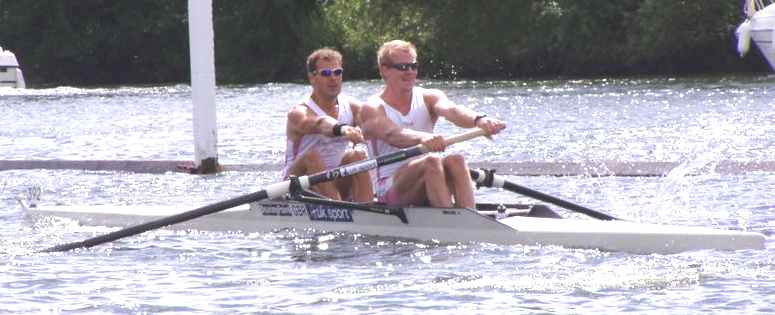
Head races
Head races are time trial / processional races that take place from autumn (fall) to early spring (depending on local conditions). Boats begin with a rolling start at intervals of 10-20 seconds, and are timed over a set distance. Head courses usually vary in length from 2,000 m to 12,000 m, though there are longer races such as the Boston Rowing Marathon.
The oldest, and arguably most famous, head race is the Head of the River Race, founded by Steve Fairbairn in 1926 which takes place each March on the river Thames in London, United Kingdom. Head racing was exported to the United States in the 1950s, and the Head of the River Charles Regatta held each October on the Charles River in Boston, Massachusetts,
USA is now the largest rowing event in the world.
These processional races are known as 'Head Races', because, as with bumps racing, the fastest crew is awarded the title 'Head of the River' (as in 'head of the class'). It was not deemed feasible to run bumps racing on the Tideway, so a timed format was adopted and soon caught on.
Time trials are sometimes used to determine who competes in an event where there is a limited number of entries, for example the qualifying races for Henley Royal Regatta, and "rowing on" and "getting on" for the Oxford and Cambridge Bumps races respectively.
Bumps races
A third type of race is the bumps race, as held in Oxford (known as Torpids and Eights Week), Cambridge (known as the Lent Bumps and the May Bumps), between the London medical schools (the United Hospitals Bumps) on the Tideway and at Eton College and Shrewsbury School (which are the only schools in Britain to continue this tradition). In these races, crews start lined up along the river at set intervals, and all start at the same time. The aim is to catch up with the boat in front, and avoid being caught by the boat behind. If a crew overtakes or makes physical contact with the crew ahead, a bump is awarded. As a result damage to boats and equipment is common during bumps racing. To avoid damage the cox of the crew being bumped may concede the bump before contact is actually made. The next day, the bumping crew will start ahead of any crews that have been bumped. Bumps races take place over several days, and the positions at the end of the last race are used to set the positions on the first day of the races the next year. Oxford and Cambridge Universities hold bumps races for their respective colleges twice a year, and there are also Town Bumps races in both cities, open to non-university crews. Oxford's races are organised by City of Oxford Rowing Club[25] and Cambridge's are organised by the Cambridgeshire Rowing Association. Bumps races are very rare in the United States.
Stake races
The stake format was often used in early American races. Competitors line up at the start, race to a stake, moored boat, or buoy some distance away, and return. The 180° turn requires mastery of steering. These races are popular with spectators because one may watch both the start and finish. Usually only two boats would race at once to avoid collision. The Green Mountain Head Regatta continues to use the stake format but it is run as a head race with an interval
start. A similar type of racing is found in UK coastal rowing, where a number of boats race out to a given point from the coast and then return fighting rough water all the way.
World championships and Olympics
Rowing at the Olympic GamesMain articles: World Rowing Championships and Rowing at the Summer Olympics
The Olympic Games are held every four years, where only select boat classes are raced (14 in total):
Men: quad scull, double scull, single scull, eight, straight four, and straight pair
Lightweight Men: straight four and double scull
Women: quad scull, double scull, single scull, eight, and straight pair
Lightweight Women: double scull
At the end of each year, the FISA holds the World Rowing Championships with events in 23 different boat classes. Athletes generally consider the Olympic classes to be "premier" events and are more interested in rowing in these at the World Championships. During Olympic years only non-Olympic boats compete at the World Championships.
Rules of Racing
There are many differing sets of rules governing racing and these are generally defined by the governing body of the sport in a particular country. In the UK this is the Amateur Rowing Association, Australia this is Rowing Australia and the U.S USRowing Sets the rules. In international competition the rules are set out by the world governing body FISA. The rules may vary slightly but are generally very similar. The main notable difference between ARA rules and FISA rules is that coxes are not required to wear buoyancy aids in international events governed by FISA, whereas they are required to wear one at all times under the ARA rules.
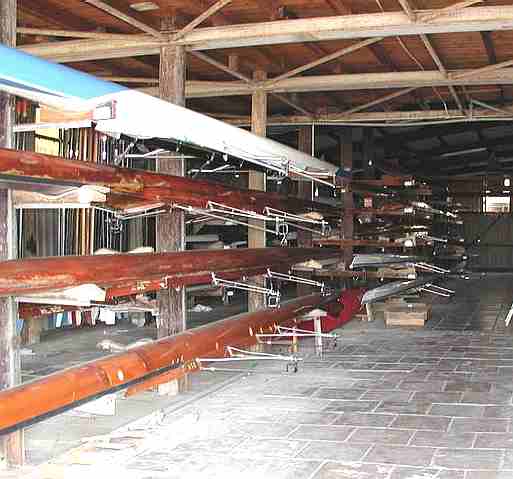
The crew
In all boats, with the exception of single sculls, each rower is numbered in sequential order, low numbers at the bow, up to the highest at the stern. The person seated on the first seat is called the bowman, or just 'bow', whilst the rower closest to the stern is called the 'strokeman' or just 'stroke'. There are some exceptions to this - UK coastal rowers, and in France, Spain and Italy rowers number from stern to bow.
In addition to this, certain crew members have other titles and roles. In an 8+ the stern pair are responsible for setting the stroke rate and rhythm for the rest of the boat to follow. The middle four (sometimes called the "engine room") are usually the less technical, but more powerful rowers in the crew, whilst the bow pair are the more technical and generally regarded as the pair to set up the balance of the boat. They also have most influence on the line the boat steers.
In most levels of rowing there are different weight classes - typically "open" or "heavyweight" and lightweight (discussed below). Competitive rowing favours tall, muscular athletes due to the additional leverage height provides in pulling the oar through the water as well as the explosive power needed to propel the boat at high speed. Open or heavyweight rowers of both sexes tend to be very tall, broad-shouldered, have long arms and legs as well as tremendous cardiovascular capacity and very low body fat ratios. Olympic or International level heavyweight male oarsmen are typically anywhere between 6'3" and 6'9" (190 cm to 206 cm) tall with most being around 6'6" (198 cm) and weighing approximately 225 lb (102 kg) with about 6 to 7% body fat. Heavyweight women are slightly shorter at around 6'1" (180 cm) and lighter than their male counterparts.
Lightweights
Unlike most other non-combat sports, rowing has a special weight category called lightweight (Lwt for short). According to FISA, this weight category was introduced "to encourage more universality in the sport especially among nations with less statuesque people". The first lightweight events were held at the World Championships in 1974 for men and 1985 for women. Lightweight rowing was added to the Olympics in 1996.
At international level the limits are:
Men: Crew average 70 kg (154 lb) - no rower over 72.5 kg (160 lb)
Women: Crew average 57 kilograms (125 lb) - no one over 59 kg (130 lb)
Women
For most of its history, rowing has been a male dominated sport. Although rowing's roots as a sport in the modern Olympics can be traced back to the original 1896 games in Athens, it was not until the 1976 Summer Olympics in Montreal that women were allowed to participate — well after their fellow athletes in similar sports such as swimming, athletics, cycling, and canoeing.
Despite its male domination, women's rowing can be traced back to the early 1800s, and an image of a women's double scull race made the cover of Harper's Weekly in 1870. In 1927, the first rowing event for women between Oxford and Cambridge was held. For the first few years it was an exhibition, and it later became a race.
In 1954, the first women's events were added to the European Rowing Championships. In 1988, the first Henley Women's Regatta was held. On April 27 1997, one of the last bastions of rowing was breached when, at an Extraordinary General Meeting, Leander Club voted to admit women as members. This rule met a condition imposed by UK Sport and qualified Leander to receive a £1.5 million grant for refurbishment from the Lottery Sports
Fund.
At international level, women's rowing traditionally has been dominated by Eastern European countries, such as Romania, Russia, and Bulgaria, although other countries such as Germany, Netherlands, Canada, and New Zealand often field competitive teams. The United States also has often had very competitive crews, and in recent years these crews have become even more competitive given the surge in women's collegiate rowing due to title IX, which is set up to equalize funding between men and woman athletics at the collegiate level , and the establishment of the NCAA Rowing Championships for women which is not set up for men.
Adaptive athletes
Adaptive rowing is a special category of races for those with physical disabilities. Under FISA rules there are 4 boat classes for adaptive rowers; mixed (2 men and 2 women) LTA (Legs, Trunk, Arms), mixed (1 man and 1 woman) TA (Trunk and Arms), and men's and women's A (Arms only). Events are held at the World Rowing Championships and are also due to take place at the 2008 Summer
Paralympics.
Terminology and Event nomenclature
Rowing events use a systematic nomenclature for the naming of events, so that age, gender, ability and size of boat can all be expressed in a few numbers and letters. The first letter to be used is 'L' or 'Lt' for lightweight. If absent then the crew is open weight. This can be followed by either a 'J' or 'B' to signify junior (under 19 years) or under 23 years respectively. If absent the crew is open age (the letter 'O' is sometimes used). Next is either an 'M' or 'W' to signify if the crew are men or women. Then there is a number to show how many athletes are in the boat (1,2,4 or 8). An 'x' following the number indicates a sculling boat. Finally either a + or - is added to indicate whether the boat is coxed or coxswainless.
Some events will use an experience rating to separate races. In the UK boats are classed as "Elite" (or "Open"), "Senior 1/2/3/4" or "Novice", depending on the number of wins the athletes have accumulated. Masters events use age ranges to separate crews of older rowers. In Australia, there are three distinct elite racing classes: Junior (19 yo and under), Senior B (Under 23 yo), Senior A (Open age)
Examples:
M8+ or 8+ men's eight (Always coxed. Sometimes written as 8o for "8-oared".)
W4- women's coxless four (or "straight four")
LM2- lightweight men's coxless pair
BM1x men's single sculls under age 23
JW4x junior women's quad
Masters WC2x masters women's double sculls with average crew age between 43-49
Mixed Masters 8+ coxed eight with 4 women and 4 men as rowers and a coxswain of either gender
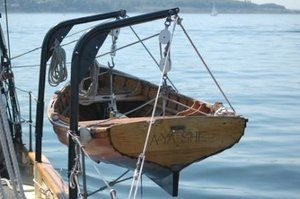
Typical
dinghy on davit setup
LINKS
and REFERENCE
Organizations
General
Following
her successful crossing of the Atlantic in 2006, Roz
Savage is bidding to
be the first woman ever to row solo across the Pacific Ocean.
Her 3-stage row launches from San Francisco in July
2007
|

|
Ralph
Tuijn (Netherlands), -
after successful row across the Atlantic E-W in double with his
brother Michael, is currently rowing solo the Pacific E-W from
Callao, Peru to Brisbane, Australia.
|
|
|
|
|

|
Website of
Rachel
Smith and Lin Griesel (UK) , entrants in 2007 Race
from La Gomera to Antigua.
As well as setting a new record, their second challenge will be
to raise over £100,000 for Breast Cancer Care
|
|
|
|
|

|
Brothers
Joseph and Andrew Jordon-White
are determined to complete the crossing of the Atlantic from La
Gomera to Antigua through exhaustive preparation and an
underlying drive to challenge themselves physically and
mentally...
|
|
|
|
|

|
Wave
Vidmar will attempt to row across the North Atlantic
Ocean, from USA to Europe, likely ending in England. He'll start
in June 2008, in his custom, high-tech, hand-made 24 foot
ocean row boat.
|
 |
|
EXPLORERSWEB.
COM |
|
 |
|
EXPLORERSWEB.
COM — expeditions to three extreme targets on the
Planet: Everest and K", Arctica and Antarctica, World
Ocean
|
|
| users.ox.ac.uk |
|
New
Rowing Information from Around the World |
|
|
|
 |
|
The
official world rowing website |
|
|
|
 |
|
Portal
of extreme adventures (RUS) |
|
|
|
 |
|
This
website chronicles adventures
and profile adventurers.
if
you are a person who
frequently thinks or says "Oh man, my ass is wet,"
then you are probably outside a lot, engaged in challenging,
intense, asswetting adventures. In other words, having a wet
ass, despite the discomfort, means you are having a hell of a
time
|
|

|
|
Les
Ecrans de l'Aventure - Dijon International Festival of
Adventure Film. Every
year in October, share the Great Adventure and travel
around-the-world with the Festival


|
|
|

|
|
Extreme
world
(formerly
"Sector") of sports, adventure, travel and science. In
Italian with online translation into English
|
|
|

|
|
Latest
Rowing News from The
Rowing Service |

Mobile
refreshment for better communicators
......

330ml
Earth Can - the World in Your Hand
|












